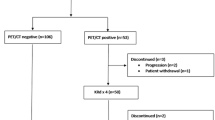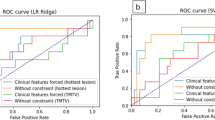Abstract
Positron emission tomography (PET) utilizing fluorodeoxyglucose (FDG) has an ever-increasing role in the management of numerous malignancies. FDG PET in lymphoma is being incorporated into the response assessment in lymphoma as published by the Imaging Subcommittee of International Harmonization Project in Lymphoma. The exact role of FDG PET in non-Hodgkin's lymphoma (NHL) associated with autologous stem cell transplant (ASCT) is unclear. Numerous studies have identified pretransplant PET scans as being highly prognostic with regard to overall and PFS after ASCT. Many included a wide range of histologies, including Hodgkin's lymphoma and NHL. In studies with mixed histologies, PFS at 2 years has been improved by as much as 82% in patients with negative pre-ASCT PET scans. In studies incorporating only patients with NHL, improvements in failure-free survival have been reported as high as 43% for patients with negative pre-ASCT PET imaging. Limitations have included inclusion of many histologies, different reported time points, small retrospective studies and variation in the interpretation of a positive PET. Validation is ongoing in larger prospective trials. Future directions include the potential incorporation of post-ASCT therapy, such as radiation therapy or maintenance antibody therapy, for patients with positive pre-ASCT PET scans.
This is a preview of subscription content, access via your institution
Access options
Subscribe to this journal
Receive 12 print issues and online access
$259.00 per year
only $21.58 per issue
Buy this article
- Purchase on Springer Link
- Instant access to full article PDF
Prices may be subject to local taxes which are calculated during checkout
Similar content being viewed by others
References
Moog F, Bangerter M, Diederichs CG, Guhlmann A, Kotzerke J, Merkle E et al. Lymphoma: role of whole-body 2-deoxy-2-[F-18]fluoro-D-glucose (FDG) PET in nodal staging. Radiology 1997; 203: 795–800.
Moog F, Bangerter M, Diederichs CG, Guhlmann A, Merkle E, Frickhofen N et al. Extranodal malignant lymphoma: detection with FDG PET versus CT. Radiology 1998; 206: 475–481.
Haioun C, Itti E, Rahmouni A, Brice P, Rain JD, Belhadj K et al. [18F]fluoro-2-deoxy-D-glucose positron emission tomography (FDG-PET) in aggressive lymphoma: an early prognostic tool for predicting patient outcome. Blood 2005; 106: 1376–1381.
Kostakoglu L, Coleman M, Leonard JP, Kuji I, Zoe H, Goldsmith SJ . PET predicts prognosis after 1 cycle of chemotherapy in aggressive lymphoma and Hodgkin's disease. J Nucl Med 2002; 43: 1018–1027.
Spaepen K, Stroobants S, Dupont P, Vandenberghe P, Thomas J, de Groot T et al. Early restaging positron emission tomography with (18)F-fluorodeoxyglucose predicts outcome in patients with aggressive non-Hodgkin's lymphoma. Ann Oncol 2002; 13: 1356–1363.
Juweid ME, Stroobants S, Hoekstra OS, Mottaghy FM, Dietlein M, Guermazi A et al. Use of positron emission tomography for response assessment of lymphoma: consensus of the Imaging Subcommittee of International Harmonization Project in Lymphoma. J Clin Oncol 2007; 25: 571–578.
Bondly C, Johnston PB, Lowe V, Ansell SM, Inwards DJ, Porrata LF et al. Positive positron emission tomography (PET) pre-autologous stem cell transplant (ASCT) in non-Hodgkin lymphoma (NHL) does not preclude successful outcome. Biol Blood Marrow Transplant 2006; 12: 18–19.
Becherer A, Mitterbauer M, Jaeger U, Kalhs P, Greinix HT, Karanikas G et al. Positron emission tomography with [18F]2-fluoro-D-2-deoxyglucose (FDG-PET) predicts relapse of malignant lymphoma after high-dose therapy with stem cell transplantation. Leukemia 2002; 16: 260–267.
Cremerius U, Fabry U, Wildberger JE, Zimny M, Reinartz P, Nowak B et al. Pre-transplant positron emission tomography (PET) using fluorine-18-fluoro-deoxyglucose (FDG) predicts outcome in patients treated with high-dose chemotherapy and autologous stem cell transplantation for non-Hodgkin's lymphoma. Bone Marrow Transplant 2002; 30: 103–111.
Spaepen K, Stroobants S, Dupont P, Vandenberghe P, Maertens J, Bormans G et al. Prognostic value of pre-transplantation positron emission tomography using fluorine 18-fluorodeoxyglucose in patients with aggressive lymphoma treated with high-dose chemotherapy and stem cell transplantation. Blood 2003; 102: 53–59.
Filmont JE, Czernin J, Yap C, Silverman DH, Quon A, Phelps ME et al. Value of F-18 fluorodeoxyglucose positron emission tomography for predicting the clinical outcome of patients with aggressive lymphoma prior to and after autologous stem-cell transplantation. Chest 2003; 124: 608–613.
Svoboda J, Andreadis C, Elstrom R, Chong EA, Downs LH, Berkowitz A et al. Prognostic value of FDG-PET scan imaging in lymphoma patients undergoing autologous stem cell transplantation. Bone Marrow Transplant 2006; 38: 211–216.
Filmont JE, Gisselbrecht C, Cuenca X, Deville L, Ertault M, Brice P et al. The impact of pre- and post-transplantation positron emission tomography using 18-fluorodeoxyglucose on poor-prognosis lymphoma patients undergoing autologous stem cell transplantation. Cancer 2007; 110: 1361–1369.
Kassim A, Mineishi S, Greer J, Koyama T, Chinratanalab W, Brandt S et al. Post-transplant positron emission tomography using fluorine 18-fluor-deoxyglucose ([18F]FDG-PET) correlates with outcome in patients with aggressive non-Hodgkin's lymphoma undergoing high dose chemotherapy followed by autologous stem cell transplantation (HDC/ASCT). Blood 2004; 104: 259a.
Alousi A, Saliba R, Okoroji G, Hosing C, Samuels B, Champlin R et al. The influence of PET-gallium (PET/Gal) status and high-dose rituximab in patients with aggressive, large, b-cell lymphoma (LBCL) receiving autologous stem cell transplants. Blood 2006; 108: 3058a.
Schot BW, Zijlstra JM, Sluiter WJ, van Imhoff GW, Pruim J, Vaalburg W et al. Early FDG-PET assessment in combination with clinical risk scores determines prognosis in recurring lymphoma. Blood 2007; 109: 486–491.
Author information
Authors and Affiliations
Corresponding author
Rights and permissions
About this article
Cite this article
Johnston, P., Wiseman, G. & Micallef, I. Positron emission tomography using F-18 fluorodeoxyglucose pre- and post-autologous stem cell transplant in non-Hodgkin's lymphoma. Bone Marrow Transplant 41, 919–925 (2008). https://doi.org/10.1038/bmt.2008.82
Received:
Accepted:
Published:
Issue Date:
DOI: https://doi.org/10.1038/bmt.2008.82
Keywords
This article is cited by
-
Long-term remissions in patients with early relapse of diffuse large B-cell lymphoma following high-dose chemotherapy, autologous stem cell transplantation, and radiotherapy of residual disease
Strahlentherapie und Onkologie (2022)
-
R-GEM-Lenalidomide versus R-GEM-P as second-line treatment of diffuse large B-cell lymphoma: results of the UK NRCI phase II randomised LEGEND trial
Annals of Hematology (2020)
-
The role of 18F-fluorodeoxyglucose positron emission tomography at response assessment after autologous stem cell transplantation in T-cell non-Hodgkin’s lymphoma patients
Annals of Hematology (2013)
-
Early post-transplantation positron emission tomography in patients with Hodgkin lymphoma is an independent prognostic factor with an impact on overall survival
Annals of Hematology (2011)
-
Unifying the predictive value of pretransplant FDG PET in patients with lymphoma: a review and meta-analysis of published trials
European Journal of Nuclear Medicine and Molecular Imaging (2010)



